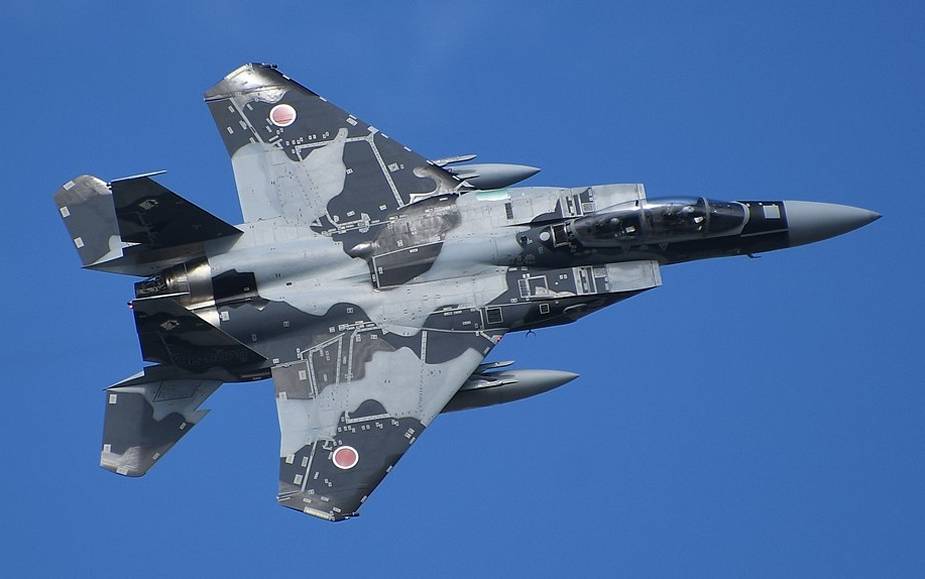The U.S. Department on March 16 announced that Boeing has been awarded a not-to-exceed $24,550,000 undefinitized contract modification for the F-15 Japan Super Interceptor program. The modification provides for the Foreign Military Sales requirement to add electronic warfare system initial non-recurring engineering for the Japan Air Self Defense Force.
Follow Air Recognition on Google News at this link
 F-15DJ of the Tactical Fighter Training Group (JASDF) (Picture source: Wikipedia)
F-15DJ of the Tactical Fighter Training Group (JASDF) (Picture source: Wikipedia)
Work will be performed in St. Louis, Missouri, and is expected to be completed by Dec. 31, 2028. This contract involves 100 percent Foreign Military Sales to Japan, and is the result of a sole-source acquisition. Foreign Military Sales funds in the amount of $12,029,500 are being obligated at the time of the award. Air Force Life Cycle Management Center, Wright-Patterson Air Force Base, Ohio, is the contracting activity.
The Mitsubishi F-15J/DJ Eagle, based on the McDonnell Douglas F-15 Eagle and in use by the Japan Air Self-Defense Force (JASDF), was produced under license by Mitsubishi Heavy Industries. The subsequent F-15DJ and F-15J Kai variants were also produced. Japan is the largest customer of the F-15 Eagle outside the United States. In addition to combat, F-15DJ roles include training. The F-15J Kai is a modernized version of the F-15J.
F-15Js have been armed with the Japanese-built AAM-3 missile, an improved AIM-9 Sidewinder follow-on with distinctive "barbed" forward fins. Japan has been investigating an advanced fighter to replace the F-15, meanwhile, the F-15J fleet is being modernized. On 28 July 2003, the first upgraded F-15J (#928) made its first flight, and it was delivered to the JASDF Air Development Test Wing on 21 October 2003.
On 10 December 2004, the Japanese Government approved a Mid-Term Defense Program (MTDP) to modernize the F-15J MSIPs over five years in accordance with the new National Defense Program Guidelines. The upgrade is being implemented in phases, but ultimately the upgrade will include a new ejection seat; replaced IHI-220E engines; more powerful processor; uprated electrical generation and cooling capabilities to support more avionics and the Raytheon AN/APG-63(V)1 radar. which has been produced under license by Mitsubishi Electric since 1997. Raytheon expects the radar will ultimately be installed in 80 F-15Js. The new radar will support the AAM-4 missile, the Japanese answer to the AMRAAM.
The Ministry of Defense (MoD) requested the modernization and deployment of reconnaissance aircraft in June 2007, and it was planned to upgrade some F-15Js with synthetic aperture radar pods; these aircraft would replace the RF-4 Phantom IIs currently in service.
On 17 December 2009, the reconnaissance upgrade disappeared from the budget after the Democratic Party of Japan took power following the General Election in 2009, and priority was given instead to the improvement of the F-15J and the Mitsubishi F-2. The number of F-15J upgrades was increased from 26 to 48, and the MoD purchased part of the modernization for 38 fighters. However, the full budget for modernization is incomplete. 48 F-15Js will get a Link 16 datalink and helmet-mounted sight. The helmet-mounted sight will support the AAM-5 dogfighting missile, which will replace the AAM-3.
On 17 December 2010, modernization was funded for 16 F-15Js but the MoD reduced this to 10 F-15Js.
In late October 2019, the US Defense Security Cooperation Agency approved a possible sale to Japan of up to 103 APG-82(v)1 Active Electronically Scanned Array (AESA) Radars, 116 Advanced Display Core Processor II Mission System Computers and 101 AN/ALQ-239 Digital Electronic Warfare Systems for the upgrade of 98 F-15Js to a "Japanese Super Interceptor" (JSI) configuration for an estimated cost of $4.5 billion. It can also carry a large air-to-surface weapon on its centerline weapon station, such as an AGM-158B JASSM-ER or AGM-158C LRASM, giving the aircraft an air-to-ground and anti-ship capability. In July 2020, Boeing signed an agreement with MHI to provide assistance and support to the program. Work is set to start in 2022.
















